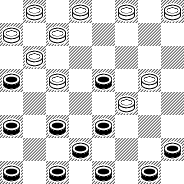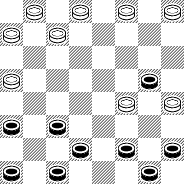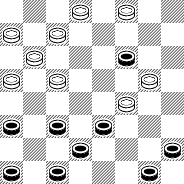A Switcher Autopsy

A Switcher Autopsy
Featuring new defenses from KingsRow and Chinook!
Notes by Richard L. Fortman, February 24, 2005.
Editorial assistance and additional computer analysis by Brian Hinkle using KingsRow.
1. 11-15 21-17 A
2. 9-13 B 25-21 C
3. 8-11 D 17-14 E
4. 10x17 21x14
5. 6-10 F 22-17 G
6. 13x22 26x17
7. 15-18 H 24-20 I
8. 2-6 J 29-25 K
9. 18-22 L 25x18
10. 10-15 28-24 M
11. 15x22 32-28 N
12. 6-10 O 23-18 P
13. 22-25 30x21
14. 10-15 27-23
15. 15x22 14-10
16. 7x14 17x10
17. 22-25 23-19
18. 11-15 20-16
19. 25-29 16-11
20. 29-25 11-7
21. 25-22 7-2
22. 5-9 Q 10-6 ? R
23. 1x10 2-7
24. 9-14 7-11
25. 14-18 31-27 S
26. 4-8 T 11x4
27. 22-26
Tinsley defeated Lowder, Game 4, 1975 Florida Open.
A - History tells us that James Wyllie used this weak reply in many of his GAYP exhibitions in order to "switch" or defer his opponents from their favorite Old 14th or Single Corner lines.
B - Applying the cramp which forms the opening. Other replies in 9-14 or 8-11 are seen in the 3-move openings.
C - To fill in the hole, to prepare for the exchange- other ways in 24-20 (Scott's Snake) or 23-18 are inferior, although Asa Long once tried the latter in the 1927 2nd international match vs. Harry Moulding, the English 'weak link.' Asa once told me, "I had won the first game with black and since this was close to the finish, with our team far ahead, I decided to go for the win with the weak side, much to the dissatisfaction of team captain Gus Heffner. Upon reflections it was a mistake, as I had to struggle to draw. (Black might have scored with Rubin's "Whipper-Snapper" gambit. --RLF)
D - Standard, as 5-9 instead is more often seen from the 9-13, 21-17, 5-9 opening.
E - Of the three major defenses, this was the original, as favored in the Willie Era - both Heffner and Bradford favored the 24-19 exchange, as witnessed in the 2nd I.M. whereas the third, the Andrew Jackson 30-25 remained in obscurity until adopted by Rubin in the 1929 7th American tournament (Cedar Point) or the 4-8 Switcher played in the 2nd I.M. The trunk reply was the overwhelming favorite; adopted 37 times followed with 24-19 5 times: then 23-18 and 24-20 - with 30-25 a notable absentee! - the last named was a lifetime favorite with Marion Tinsley. He told me he once asked his close friend Walter Hellman why he had stayed with the less restrictive 17-14x and Walter replied, "Well, Marion, they can only play one move at a time against it, and I know them all!"
F - Following up with the bind originated at note B; 4-8 instead allows a 'doctor' idea with 29-25, 6-10 and 23-19 etc. shown to draw.
G - Necessary. White cannot delay with 29-25, 10-17 and 25-21 as 4-8* 21-14 then 15-18x* etc. to a p.p. black win.
H - Marion Tinsley had long favored the 4-8 and 1-6 attack throughout his long career but when faced with a 'do or die' decision, playing Elbert Lowder in the final 4th game of the final round in the 1975 Florida Open ty. he "switched' to the text. In discussing this game on a later visit to Springfield, Ill., he said, "As you know, I had to win this game, as a draw would win this tournament for Lowder on honor points so I decided this "surprise" element might confuse him; however, as play progressed, I began to think it might have been a mistake as he kept on making the necessary moves - as it turned out. Only a little 'swindle' saved me."
I - Checker theory recommends advancing toward the center and avoid side moves such as this, but there are exceptions to every "rule" that have been proposed - here 24-19? 4-8 29-25 11-15 28-24 8-11 17-13 10-17 23-14 then either 15-18 or 17-22 rupture the white formation - and if 29-25 instead, black has Wyllie's 18-22 pitch to penalize the defense by his long time opponent Robert Martins. However, KingsRow prefers 7. ...23-19

BLACK
Black to Play
J - Holding the bridge, instead of the other formidable attack in 1-6, followed with 3-8, leading into the classic win by 18 year old Asa Long over his more experienced opponent, English champion Alfred Jordon in the semi-finals of the 1922 5th Amer. Ty. at Boston, Asa then going on to win his first American tournament by defeating Jordon again in the final round. While visiting me in 1985, Asa commented, "Perhaps, my most satisfactory win, as I had little respect for Jordon as a sportsman, forcing me to play out endings as if I was a beginner."
K - Here the early 28-24 loses after 6-9*, as shown in Master Play (see Marion Tinsley's remarks in note H). However, there is a new sound defense confirmed to draw by Chinook with 17-13x! No analysis was sent in from Jonathan Schaeffer so KingsRow provided this line: 8. ...17-13 9. 10x17 23x14

BLACK
Black to Play
L - Black is now confined to this one powerful reply.
M - Also, 27-24, 15-22 and the key 32-27 is the same, as played in an obscure game, J. Steele vs. Harry Pillsbury - the last named was rated as the strongest 'mixed' player of the 'sister games' - chess and checkers, along with Newell Banks.
N - A valuable "waiting" move, again avoiding the 24-19 advance shown to lose. As Tinsley once observed, " Knowledge is power!"
O - The position reached by Tinsley vs. Lowder, mentioned in note H. I was not present, but Howard Owen wrote me later that the majority of players had completed their round but stayed over to watch the finish - he said, " The tension was high, and you you could almost hear a pin drop! Was the world champion on the verge of losing his first tournament since Paxton in 1950?"
P - The first small chink in white's armor, giving the champion a faint ray of hope - here, Wyllie's 24-19 (avoided earlier) is now best, as played vs. Robert Martins - in a later letter, Tinsley told me he had been over this 23-18 in his early career, when stationed at the Great Lakes Naval Center in Chicago (1946) and studying at the Rex Wood Library in Gary, Ind. He said he had found a little 'kink' (as he put it) that varied from the Master Play variation, and later tried vs. his playing partner Roy Hunt. - Instead of either 24-19 or 23-18, Ed Gilbert's KingsRow checker software came up with a new defense in 23-19! that has remained hidden for the past century and a half! ... 12. ... 23-19

BLACK
Black to Play
Q - The play from note P is virtually forced - the text is the Tinsley 'kink' (or cook) as mentioned in note P which varies from the Master Play 22-18, which also requires care to draw after 31-27* (not 21-17, 18-22 to a black win) then 4-8 and the 10-6 exchange to draw.
R - With the clock running, the position is murky. It is obvious that white must pitch to escape the bridge, and on the surface it might appear that either way would draw - but not so! This loses, whereas, 10-7* escapes after 3-10, as played by Hunt, although he didn't send their conclusion. I looked at 2-7* (as 2-6 lets in 4-8, 6-13 and 8-11) 9-14, 7-11, 22-18, 11-7, 18-23, 24-20 etc. to draw.
S - The king move with 11-7 allows18-23, 7-14 22-18 19-10 and 18-9 strands the piece, black wins.
T - A neat conclusion to a hard fought game.
You can email the Webmaster with comments on this article.